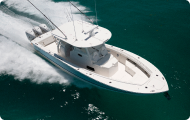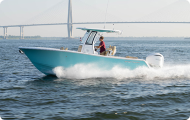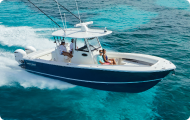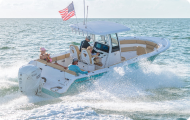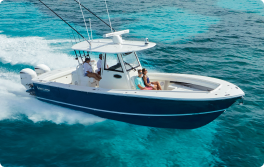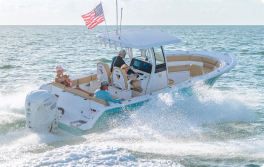When the warmer months of Florida arrive the varieties, numbers and weight of the fish noticeably increase. I mean, who doesn’t like warmer, tropical water? The fish have the right idea!
Typically, saltwater fishing season is April through September (so we’re right in the middle!), while freshwater’s best months are spring through November. Since this month is known to be generally more windier than others, your best time to hit the water is early in the morning, avoiding the afternoon gusts. Useful apps like Windy are great for checking weather conditions. Another useful tool is the website Tides4Fishing.com, which is a great go-to for checking everything from fish activity, tidal coefficients, tides (high/falling/low/rising), visibility, fishing conditions, and swell charts. It is a one page dashboard for everything you’d want to see! Just search your area and you’ll be surprised at all the info they’ve compiled for you on a daily basis. You can also search days out in advance which will help you plan your fishing expedition. Need more reasons to research your area before you hit the water? From Tides4Fishing.com: “The effects of Water Temperature: Fish are cold blooded, which means their metabolism is strongly influenced by the temperature of their surrounding environment. Fish want to stay comfortable. Consequently, even a small change or break will cause fish to move from one location to another.” * This is why it’s great to research your fishing areas before heading out. All in all, if you’re looking for unique varieties of fish you wouldn’t normally catch, June is a great month to flex your angler skills!
Here are a few varieties of fish that you are more prone to catch during this time:
Yellow Tail Snapper
The yellowtail snapper is a very popular fish characterized by its vibrant yellow tail and a streamlined body with a distinct mid-body stripe. Yellowtail snapper are highly sought after by anglers for their delicious white meat and are known for their strong fighting ability!
Bait options:
- Bait: Yellowtail snapper are primarily carnivorous and feed on a variety of small fish, crustaceans, and mollusks. Some effective bait options for yellowtail snapper include small live or dead fish like pilchards, ballyhoo, or shrimp. Squid strips or small pieces of cut fish can also work well.
- Water Depth: Yellowtail snapper are commonly found in depths ranging from 30 to 120 feet (9 to 37 meters), although they can be caught in shallower waters as well. Look for reefs, wrecks, or rocky structures where these fish congregate.
- Water Temperature and Clarity: Yellowtail snapper prefer clear, warm waters with temperatures between 70 and 85°F (21 to 29°C). They are commonly found around the tropical and subtropical regions, where water clarity is often better.
- Current: Yellowtail snapper are known to prefer areas with moderate to strong current flow. Look for areas where there is a good amount of water movement, as this can enhance your chances of catching them.
- Tackle and Techniques: Use light to medium spinning or baitcasting gear with 10- to 20-pound (4.5-9 kg) test line. You can employ various techniques, such as bottom fishing with a sliding sinker rig or using a small jig or bucktail tipped with bait. Drifting or slow trolling near the targeted structure can also be effective.
Mutton Snapper
Mutton snapper are highly regarded by anglers for their excellent table fare and their challenging nature to catch! Mutton are typically opportunistic feeders, but just be ready for the hard catch! It’s important to consider the fishing location and conditions when choosing bait. Mutton snapper are often found near reefs, wrecks, and other structure, so targeting these areas can increase your chances of success. Remember to use appropriate tackle for mutton snapper, such as medium to heavy spinning or baitcasting gear with 20- to 40-pound (9-18 kg) test line, as these fish can put up a strong fight.
Bait options:
- Live Bait: Mutton snapper are known to be partial to live bait. Some commonly used live baits include pilchards, ballyhoo, pinfish, grunts, or other small fish that are prevalent in the area where you are fishing. Hook the live baitfish through the lips or back to keep them lively and swimming naturally.
- Cut Bait: Fresh cut bait can also work well for mutton snapper. Use small pieces of fish like mullet, ballyhoo, squid, or shrimp. Make sure the bait is fresh and has a scent that can attract the fish.
- Artificial Lures: While mutton snapper are primarily bait-oriented, they can occasionally be caught on artificial lures. Jigs, soft plastic baits, or bucktail jigs in natural colors that resemble small baitfish can be effective when retrieved with a slow and subtle motion.
Grouper
Grouper are known for their stout bodies, large mouths, and strong swimming capabilities. They are highly sought after by anglers for their size, fighting ability, and because they are delicious! Who could turn down fresh grouper tacos?!
When it comes to bait selection for grouper, they are known opportunistic predators that feed on a variety of prey. The best bait to use for catching grouper can vary depending on the species and the fishing location. It’s important to match your tackle to the size and strength of the targeted grouper species. Grouper can be powerful fish, so using medium to heavy spinning or conventional gear with strong lines (30 to 80-pound test) and sturdy hooks is recommended.
Bait options:
- Live Bait: Grouper are often enticed by live baitfish. Some commonly used live baits include small fish like pilchards, pinfish, grunts, mullet, or even small lobsters and crabs if they are available. Hook the live baitfish through the lips or back to keep them active and attract grouper.
- Cut Bait: Fresh cut bait can also be highly effective for grouper. Use chunks of oily and aromatic fish such as mullet, mackerel, bonito, or squid. The scent and movement of the cut bait can attract grouper and entice them to strike.
- Whole Fish: In some cases, presenting a whole fish can be productive for targeting larger grouper. This involves using a larger baitfish, such as a whole mullet or mackerel, and allowing it to swim naturally in the water to attract the attention of the grouper.
- Artificial Lures: While grouper are primarily bait-oriented, they can be caught on various types of artificial lures. Jigs, swimbaits, and diving plugs that imitate baitfish can be effective when worked near the bottom in areas where grouper are present.
Kingfish
“Kingfish” usually refers to the King mackerel or the Spanish mackerel. Feeling ambitious and in need of a challenge? These species are known popular targets for anglers due to their fast and powerful swimming abilities, as well as their reputation as fierce fighters!
When it comes to bait selection for kingfish, they are primarily piscivorous, meaning they feed on other fish. It’s important to note that the best bait for kingfish can vary depending on the location, season, and the specific preferences of the fish in that area. It’s a good idea to consult with local anglers or fishing guides who have experience targeting kingfish in your specific location, as they can provide valuable insights and recommendations.
Remember to use appropriate tackle for kingfish, such as medium to heavy spinning or conventional gear with strong lines (20 to 40-pound test) and sturdy hooks. Kingfish are known for their speed and powerful runs, so having a robust setup is essential!
Bait options:
- Live Bait: Kingfish are known to be attracted to live baitfish. Some commonly used live baits include blue runners, pilchards, mullet, cigar minnows, or threadfin herring. Hook the live baitfish through the lips, back, or tail to allow them to swim naturally and entice the kingfish.
- Artificial Lures: Kingfish can also be targeted with various artificial lures. Trolling lures such as spoons, plugs, or feather jigs that mimic small baitfish can be effective. Choose lures with shiny and reflective surfaces to attract the attention of the kingfish.
- Dead Bait: If live bait is not available, fresh dead bait can be used to entice kingfish. Cut baitfish, such as mullet, ballyhoo, or squid, can be rigged on a wire or mono leader and presented in the water to attract kingfish.
- Flashers and Dusters: These are additional attractants that can be used in combination with bait or lures. Flashers are reflective panels or blades that create flashes underwater, while dusters are colorful skirts or feathers that create additional movement and attraction.
Sailfish
The sailfish is a popular and highly sought-after game fish found in warmer sections of the oceans, particularly in tropical and subtropical waters. It is known for its distinctive sail-like dorsal fin and its incredible speed and acrobatic leaps when hooked. Safe to say this fish will put on a show if on the line!
When targeting sailfish, it’s important to note that they are primarily predatory fish that feed on smaller fish and squid. It’s worth noting that the use of circle hooks is often encouraged when targeting sailfish to promote catch-and-release practices, as they can help reduce injury to the fish. Sailfish are typically found in offshore waters, often near structure like reefs, drop-offs, or current edges. They are known to be migratory and can be found in different regions depending on the time of year.
Bait Options:
- Live Bait: Sailfish are often enticed by live baitfish. Some commonly used live baits include ballyhoo, pilchards, goggle-eyes, threadfin herring, or Spanish sardines. Rig the live baitfish with a circle hook through the nose, back, or belly to keep them lively and swimming naturally.
- Artificial Lures: Sailfish can also be targeted with artificial lures. Trolling with large, colorful lures such as skirted trolling baits, feathers, or diving plugs can be effective. These lures mimic the movement and appearance of baitfish, attracting the attention of sailfish.
- Dead Bait: Fresh dead bait can be an alternative when live bait is not available or preferred. Rigged ballyhoo, mullet, bonito, or squid can be used as dead bait. Adding a scent trail to the bait can increase its effectiveness.
- Kite Fishing: A popular technique for sailfish is kite fishing, where a kite is deployed with live baitfish suspended from it. The kite keeps the baitfish at the surface and creates a realistic presentation that can entice sailfish into striking.
Tuna
Common types of include yellowfin tuna, bluefin tuna, and skipjack tuna. They are well-known for their streamlined bodies, speed, and powerful swimming capabilities. They are often found near reefs, seamounts or in areas with baitfish activity–so watch for those!
When it comes to bait selection for tuna, they are predatory fish that feed on a variety of prey, including smaller fish, squid, and crustaceans. Tuna can be powerful fish, so using medium to heavy spinning or conventional gear with strong lines (30 to 80-pound test) and sturdy hooks is recommended.
Bait Options:
- Live Bait: Tuna are often enticed by live baitfish. Some commonly used live baits include small to medium-sized fish like pilchards, mullet, sardines, or anchovies. Rig the live baitfish with a circle hook or a live bait rig to keep them lively and swimming naturally.
- Chunk Bait: Chunking involves cutting large baitfish, such as mackerel, bonito, or skipjack, into chunks and deploying them as bait. The chunks are typically thrown into the water to create a scent trail and attract tuna. This method can be effective when targeting larger species like yellowfin or bluefin tuna.
- Trolling Lures: Tuna can also be targeted with various trolling lures. Skirted trolling lures, feathers, diving plugs, or imitation baitfish lures can be used. Trolling at different speeds and depths can help mimic the movement of prey and entice tuna to strike.
- Jigs: Vertical jigging with metal or diamond jigs is another effective technique for targeting tuna. Jigs can be dropped to varying depths and then rapidly retrieved to imitate a fleeing baitfish. Tuna are known to respond well to this high-energy presentation.
Red Snapper
The red snapper is a highly prized saltwater fish found in the Gulf of Mexico and the southeastern coast of the United States. It is known for its vibrant red coloration, powerful jaws, and delicious white meat. Red snapper are popular targets for both recreational and commercial fishing.
When it comes to bait selection for red snapper, they are opportunistic carnivores that feed on a variety of prey, including smaller fish, squid, and crustaceans.
Red snapper are often found near reefs, wrecks, and other underwater structures, so targeting these areas can increase your chances of success. They are typically found in depths ranging from 60 to 200 feet (18 to 61 meters), although their specific location can vary depending on the season and the availability of food.
It’s important to use appropriate tackle for red snapper, such as medium to heavy spinning or baitcasting gear with 20- to 40-pound (9-18 kg) test line. Red snapper can be strong and put up a good fight, so having a sturdy setup is important.
Bait Options:
- Cut Bait: Fresh cut bait can be highly effective for red snapper. Use chunks of oily and aromatic fish such as mullet, menhaden, cigar minnows, or squid. The scent and movement of the cut bait can attract red snapper and entice them to strike. Rig the cut bait on a circle hook or a fish finder rig to keep it secure and maintain its natural appearance.
- Whole Baitfish: Presenting a whole baitfish can also be productive for targeting red snapper. This involves using a larger baitfish, such as a whole pilchard or threadfin herring, and allowing it to swim naturally in the water to attract the attention of the red snapper.
- Squid: Red snapper are known to be attracted to squid. Whole or cut squid can be used as bait. They can be presented on their own or combined with other bait options to create a scent trail and increase the chances of enticing red snapper.
- Artificial Lures: While red snapper are primarily bait-oriented, they can occasionally be caught on artificial lures. Jigs, soft plastic baits, or bucktail jigs in natural colors that resemble small baitfish can be effective when bounced along the bottom near the targeted structure.
Remember to check local fishing regulations and any specific restrictions or seasons that may apply to any of the above fish mentioned in your area. Additionally, it’s always a good idea to consult with local anglers or fishing guides who have experience targeting any of the above fish in your specific location, as they can provide valuable insights and recommendations.
Happy June fishing!!
Article & Content written by Jill Lengyel, Thunder Marine 6/15/2023.
*Source: www.tides4fishing.com


